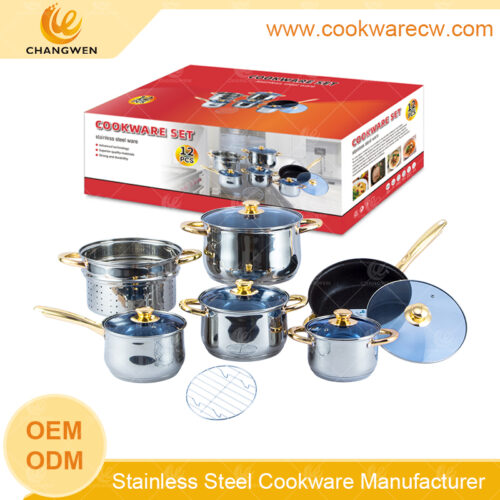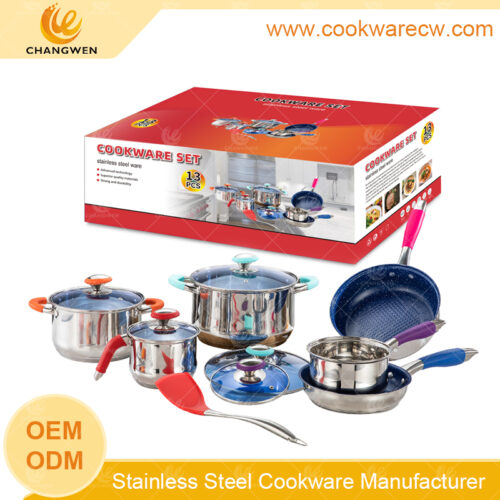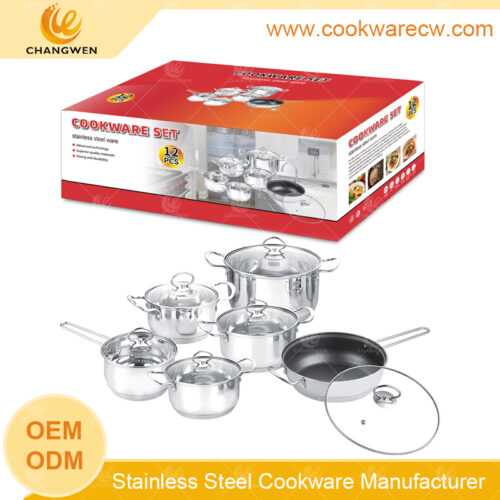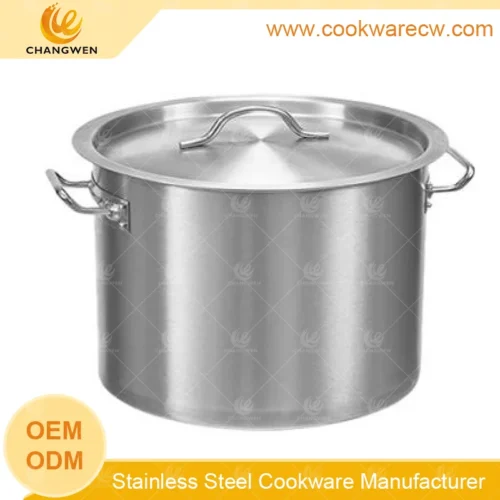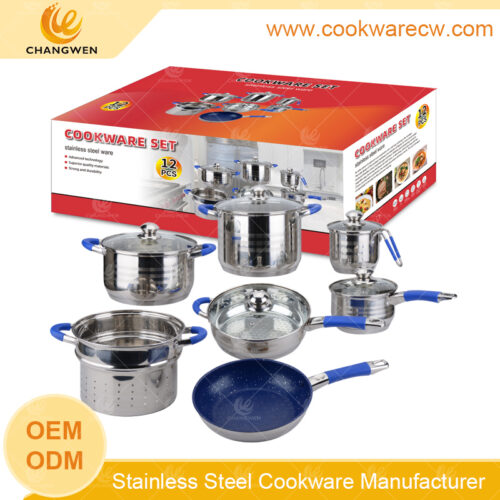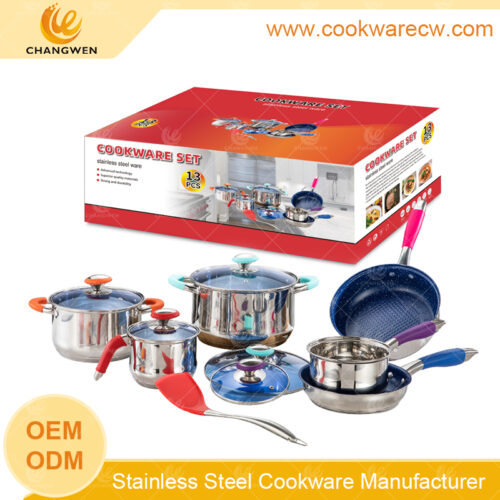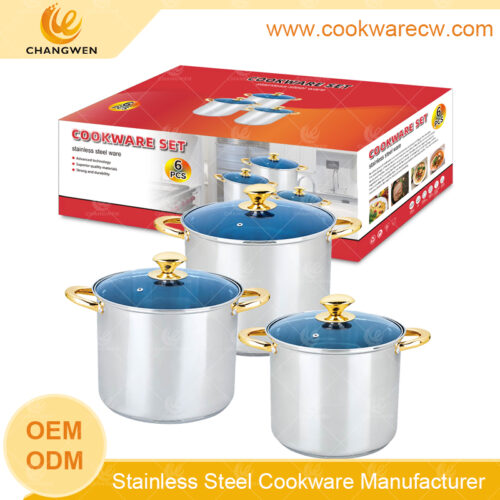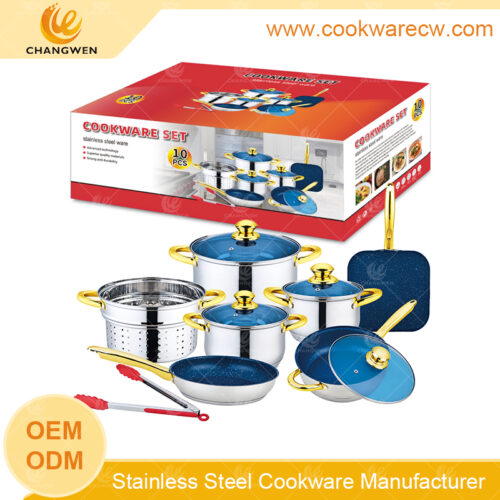Blog
Changwen is a leading cooking utensils manufacturers. We supply high quality stainless steel cooking pots and pans to all over the world. We can also customize the local hot-selling stainless steel pots and pans. Please send your requirements to Changwen.
In-Depth Comparison of Aluminum vs. Stainless Steel Cookware: Material Properties, Health Impacts, and Selection Guide
In modern kitchens, selecting the right cookware material is crucial. It not only affects cooking efficiency and food taste but also relates to durability and health safety. Changwen Kitchenware has over 20 years of experience in the cookware field, and I will compare aluminum cookware and stainless steel cookware from a professional perspective. Aluminum and stainless steel are two of the most common cookware materials; the former is renowned for its lightness and thermal conductivity, while the latter is known for its durability and stability. This article will introduce the various types of aluminum cookware, common categories of stainless steel, their key differences, and discuss health impacts.
Types and Characteristics of Aluminum Cookware
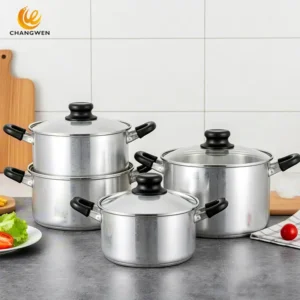
Aluminum is a lightweight metal with a density of only 2.7 g/cm³ and a thermal conductivity coefficient as high as 237 W/m·K, making it an efficient heat-conducting material. However, pure aluminum easily reacts with acidic foods, so modern aluminum cookware is typically processed. The main types are as follows:
Cast Aluminum: Formed by pouring molten aluminum into molds. This type of cookware is lightweight, affordable, with even heat conduction, suitable for frying, stir-frying, and baking. Cast aluminum is usually thicker, providing good heat distribution and avoiding hotspots. However, its drawbacks include being relatively soft, prone to deformation or scratches, especially at high temperatures. Professional tests show that the heat response time of cast aluminum cookware is 20-30% faster than stainless steel.
Forged Aluminum: Shaped from aluminum blocks using high-pressure forging processes. Compared to cast aluminum, forged aluminum has higher density, greater strength, and strong resistance to deformation, making it suitable for daily high-intensity use. Its surface is smooth with excellent thermal conductivity, often used in high-end pots. The forging process enhances material strength and improves durability, but the cost is slightly higher.
Anodized Aluminum: Treated through electrochemical anodization to form a dense aluminum oxide film on the surface (thickness about 5-25 microns). This film improves corrosion resistance and hardness, making the cookware less prone to scratches and reducing reactions with food. Anodized aluminum cookware appears gray or black, with good non-stick properties, suitable for cooking acidic foods like tomato sauce. Research shows that this treatment reduces aluminum leaching by over 90%.
Hard Anodized Aluminum: An upgraded version of anodized aluminum, with an oxide layer thickness of 50-100 microns, achieved through special processes (such as treatment in sulfuric acid) to make the surface hardness close to sapphire (Mohs hardness 8-9). It is more scratch-resistant, wear-resistant, with excellent non-stick effects, comparable to Teflon coatings but without additional layers. Hard anodized aluminum is lightweight, high-temperature resistant (up to 400°C), and a preferred choice for professional chefs, though more expensive. Compared to ordinary aluminum, its durability increases by 2-3 times.
Overall, the advantages of aluminum cookware lie in its lightness (30-50% lighter than stainless steel) and rapid heating, but maintenance is required, avoiding the use of metal utensils to prevent scratches.
Categories and Characteristics of Stainless Steel Cookware
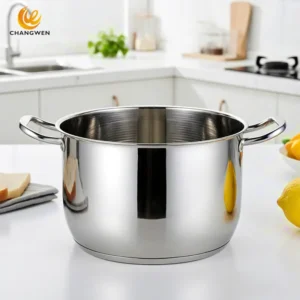
Stainless steel is an alloy composed of iron, chromium, nickel, etc., with at least 10.5% chromium content, forming a passivation layer to prevent rust. Its thermal conductivity coefficient is lower (about 16 W/m·K), but it is often composited with aluminum or copper cores to improve performance. Stainless steel cookware is high-temperature resistant, corrosion-resistant, non-reactive, and suitable for various cooking methods. Common categories are based on alloy composition:
304 Stainless Steel (also known as 18/8 or 18/10 stainless steel): 18% chromium and 8-10% nickel. This is the most common food-grade stainless steel in cookware, with good corrosion resistance, non-magnetic, suitable for induction cooktops. 304 stainless steel has a smooth surface, easy to clean, does not react with acidic or alkaline foods, and is ideal for stewing and steaming. It has high strength and deformation resistance, but pure 304 has poor thermal conductivity, often requiring multi-layer bottom designs.
316 Stainless Steel (also known as marine-grade or 316Ti): Adds 2-3% molybdenum to 304, enhancing resistance to chloride ion corrosion, especially suitable for salty foods or humid environments. 316 has higher nickel content (10-14%) and strong thermal stability, withstanding temperatures up to 870°C. The addition of titanium in 316Ti further enhances heat corrosion resistance, commonly used in high-end cookware. Compared to 304, 316 is more resistant to pitting corrosion, but costs 20-30% more.
430 Stainless Steel (10Cr17): Ferritic stainless steel with 17% Cr and no nickel, low cost but weaker corrosion resistance. Some low-priced stainless steel pots use 430 material, which is prone to rust in humid environments and should be chosen cautiously.
Other categories like 439 (ferritic stainless steel, high chromium content, magnetic, low price) are less commonly used in cookware due to inferior corrosion resistance compared to austenitic types (like 304/316). Stainless steel cookware is durable overall, lasting 10-20 years, but it is heavier and heats up more slowly.
Health Risk Control for Aluminum Cookware
Aluminum migration significantly increases in acidic environments (pH < 4.5). Experiments show that uncoated aluminum pots boiled in 4% acetic acid solution for 30 minutes have aluminum migration of 1.2 mg/dm², while hard anodized aluminum pots only have 0.03 mg/dm². The World Health Organization (WHO) recommends that adult weekly aluminum intake should not exceed 2 mg/kg body weight, so focus on:
Coating Integrity: Damaged Teflon non-stick coatings can increase aluminum migration by more than 10 times. Avoid using aluminum pots for long-term stewing of acidic ingredients like tomatoes or lemons. Germany’s LFGB standard clearly requires that aluminum tableware not be used for storing foods with pH < 3.5.
Health Advantages of Stainless Steel Cookware
Stainless steel achieves corrosion resistance through a dense chromium oxide passivation film (thickness 2-5 nm), which is far more stable than aluminum oxide films:
Heavy Metal Migration Control: Stainless steel tableware boiled in 4% acetic acid solution for 30 minutes has lead migration ≤ 0.01 mg/dm² and cadmium ≤ 0.005 mg/dm².
High-Temperature Adaptability: 304 stainless steel has a melting point of 1400°C and can withstand dry burning at 500°C without deformation.
Aluminum vs. Stainless Steel Cookware: The Core Differences
Physical Performance Comparison
| Specifications | Aluminum Cookware (Hard Anodized) | Stainless Steel Cookware (304) |
|---|---|---|
| Density (g/cm³) | 2.7 | 7.93 |
| Thermal Conductivity (W/m·K)</td > | 237 | 16.2 |
| Hardness (HV) | 800-1000 | 180-220 |
| Melting Point (°C) | 660 (Oxide Film Melting Point 2050) | 1400 |
Application Scenarios: Aluminum pots are suitable for quick heating (such as frying, stir-frying, boiling water), while stainless steel pots are ideal for slow stewing and pressure cooking.
Processing Techniques and Costs
Aluminum Cookware: Cast aluminum process has low cost (about 20 yuan/kg), but yield rate is only 70%; forged aluminum doubles the cost (40 yuan/kg), with yield rate increasing to 90%. Hard anodized adds 15% cost but extends lifespan by 3-5 times.
Stainless Steel Cookware: 304 stainless steel raw material costs about 35 yuan/kg, composite steel (aluminum + stainless steel) reaches 60 yuan/kg. High-end brands use laser welding processes, increasing single pot cost by 30%.
Health Impact Analysis
Health is a core consideration in choosing cookware. Aluminum cookware has been associated with potential aluminum ion leaching and Alzheimer’s disease, but authoritative research (such as from the Nutrition Facts Organization) shows no conclusive evidence that daily use causes health issues. Uncoated aluminum may release trace amounts of aluminum in acidic foods (daily intake limit 40 mg/kg body weight), but anodized and hard types have extremely low leaching rates, deemed safe by the FDA. Health Canada confirms that aluminum cookware is harmless under normal use.
Stainless steel cookware is generally safe but may leach small amounts of nickel and chromium, especially in new or scratched pots. The leaching from 304 and 316 is far below WHO limits (nickel < 0.2 mg/L), with no impact on most people. Those allergic to nickel should choose 316, as its molybdenum enhances stability and reduces leaching. Research shows that in neutral cooking media, metal release from both is within safe limits. Avoid high-temperature empty burning or using damaged cookware to minimize risks.
Compared to copper (prone to oxidation, requires maintenance) and ceramic (brittle), aluminum and stainless steel are more safe and reliable. If concerned about health, prioritize coated or composite materials.
Purchasing Recommendations
From a health perspective, choose hard anodized aluminum or 316 stainless steel, avoiding aluminum pots with damaged coatings and inferior stainless steel.
Which is Better: Aluminum vs. Stainless Steel Cookware
“Which is better” depends on needs. If pursuing lightness, rapid heating, and affordability, aluminum cookware (such as hard anodized) is ideal; if emphasizing durability, non-reactivity, and longevity, stainless steel (like 316) is superior. Health-wise, both are safe, with modern processing eliminating most concerns. It is recommended to purchase based on cooking habits and refer to authoritative certifications like NSF. Ultimately, high-quality cookware can enhance quality of life, but proper use is key.
Popular Blog
How to use the stainless steel pot and make it more useful?
Which One is Better or best for value,3 Ply or 5 Ply?
Advantages and Disadvantages of Chinese Cookware
Taboos for using stainless steel tableware
3-Ply vs. 5-Ply Stainless Steel Cookware
How do I find the manufacturer of cookware
How to deal with rusty cast iron pot
Advantages and disadvantages of stainless steel cookware
Why choose stainless steel for cookware?
How Do You Keep Food From Sticking to Stainless Steel
Tags
Recommend Products

olla de cocina 12pcs cookware set non-stick coating frypan 24cm steamer pot with a stainless steel kitchenware wire rack CW-M1205

popular stainless steel pots 13pcs cookware set with heat insulated colored silicone and glass lids milkpot casseroles nonstick frypan set CW-M1206G

New design stainless steel 12pcs pots wholesale wire handle and knob cookware mirror polished saucepan casserole kitchen pots nonstick coated frypan CW-M1218

Stainless Steel Stock Pot For Restaurants CW-SP002

12pcs stainless steel cooking pots & pans set with color silicon handles coating conic frypan 24cm pasta pot in China CW-M1311

China manufacturer stainless steel pots and pans 12pcs cooking set fry pan nonstick set mirror polished cookware 3.0L whistling tea kettle soup stock pot kitchen set steamer rack CW-M1206G

Large Stainless Cook Pot CW-M0607

Stainless steel cookware set nonstick pans and pots casserole pot frying pan steamer with glass blue lid and a kitchenware clip CW-M1203

